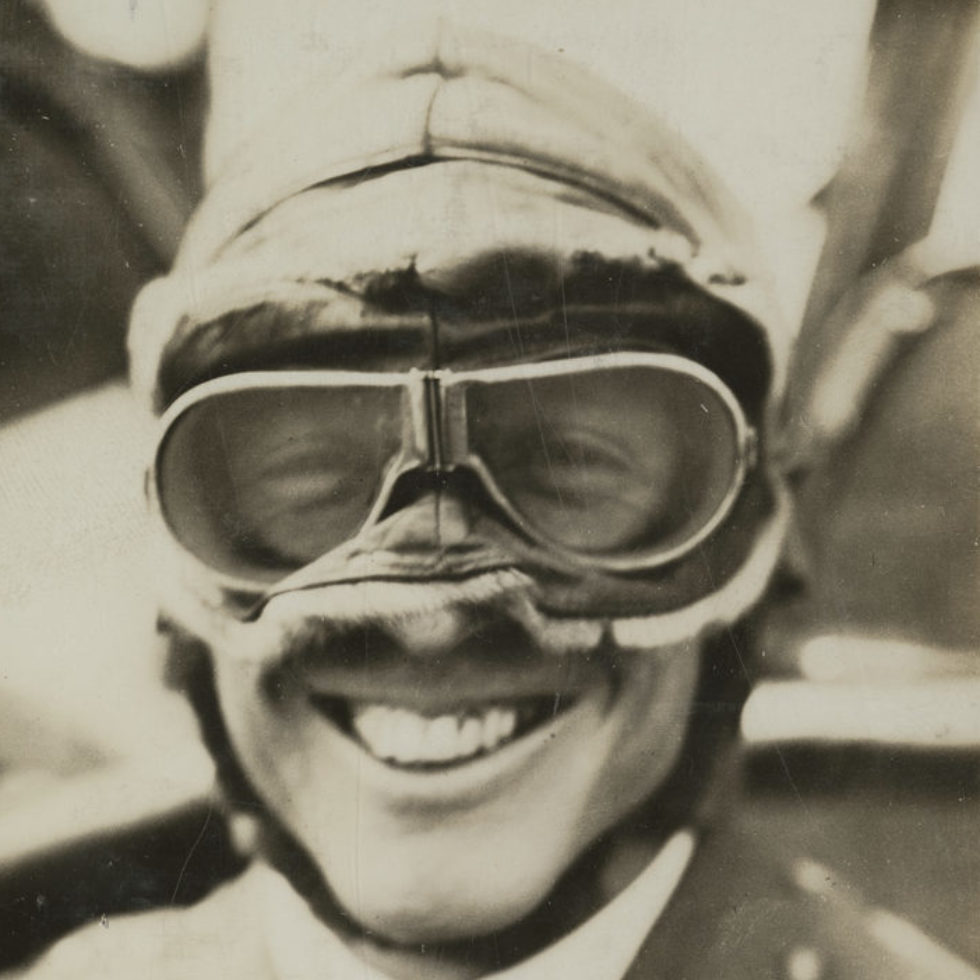
Sir Ross Smith was one of the most highly decorated allied airmen of World War I, being awarded the Military Cross and Bar, the Distinguished Cross and two Bars and the Air Force Cross. He was knighted in December 1919 for his flight from England to Australia, and was also awarded the Hejaz Order of the Nahda, Fourth Class, of the Kingdom of Hijaz.
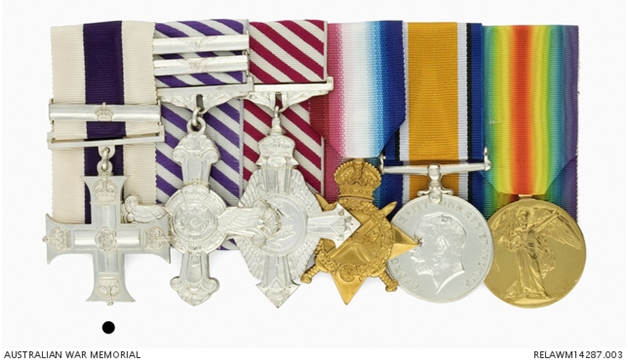
Sir Ross was awarded two Military Crosses.
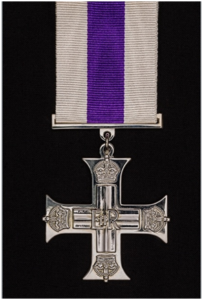 Lt Ross Macpherson Smith. Australian Light Horse Regiment attached to Australian Royal Flying Corps.
Lt Ross Macpherson Smith. Australian Light Horse Regiment attached to Australian Royal Flying Corps.
The Citation read:
“For conspicuous gallantry and devotion to duty when his pilot descended to the rescue of an officer who had been forced to land. On landing, he held the enemy at bat with his revolver, thus enabling his pilot to rescue the officer and to safely fly away his machine.”
Lt Ross Macpherson Smith. Australian Light Horse Regiment and Australian Flying Corps.
The Citation read:
“For conspicuous gallantry and devotion to duty. He was one of two pilots who carried out a remarkable series of photographs in one flight, completely covering an important area of forty-five square mile. On a later occasion he successfully bombed an important bridge head from a low altitude, and his work throughout, as well as his photography, has been invaluable and characterised by the most consistent gallantry.”
The British Military Cross (MC)
The MC is awarded in recognition of “an act or acts of exemplary gallantry during active operations against the enemy on land” to all members of the British Armed Forces and formerly of the members of the forces of Commonwealth countries.
It was established during World War I for junior officers, as there was no decoration for them for acts of bravery in the face of the enemy. Awarded to members of the Australian Flying Corps who came under Army control and to junior officers in the Royal Navy and Royal Marines. Awards were extended to majors by an amending warrant of 1931.
The award is no longer awarded in the Australian Honours system.
Description. An ornamental cross with straight arms terminating in broad finials. On the finials of each arm of the cross is an Imperial Crown and in the centre of the cross is the Imperial and Royal Cypher of the reigning sovereign (GV, GVI, or EIIR). The reverse is plain with the year of the award engraved on the lower arm.
Ribbon. A watered white ribbon (1.375″ wide), with a central purple stripe (0.5″ wide).
Sir Ross was awarded three Distinguished Flying Crosses.
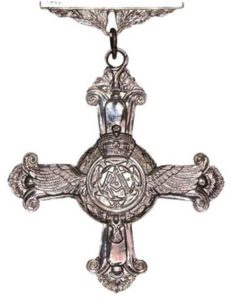 Capt. Ross Macpherson Smith, MC. Australian Light Horse and Australian Flying Corps. Egypt
Capt. Ross Macpherson Smith, MC. Australian Light Horse and Australian Flying Corps. Egypt
The Citation read:
“During the months of June and July, these officers (Smith and his observer Lieut Walter Kirk) accounted for two enemy machines, and they have be conspicuous for gallantry and initiative in attacking ground targets, frequently at very low altitudes. The keenness and fine examples set by these officers cannot be over-estimated.”
Capt. Ross Macpherson Smith, MC, DFC. Australian Light Horse and Australian Flying Corps. Egypt
The Citation read:
“During the operations prior to October, 1918, he took part in numerous engagements involving flights of 150 to 200 miles, and succeeded in doing extensive damage to the enemy’s hangars, railways etc. Captain Smith displayed most consistent gallantry with marked ability in all his work, whether bombing by night or day or in personal encounters in the air. Whilst operating with the Sheriffian forces he destroyed one enemy machine and brought down two others out of control in the desert.”
Capt. Ross Macpherson Smith, MC, DFC Australian Light Horse and Australian Flying Corps. Egypt.
The Citation read:
“On the 19th October this officer, with Lieut A.V. McCann as observer, engaged and drove down an enemy two-seater. As it appeared to land intact he descended to a low altitude and, with machine gun fire, forced the occupants to abandon the machine; he then landed alongside it, and while his observer covered the enemy officers, he set light to their machine and completely destroyed it. To have effected a landing in an unknown country, many miles in rear of the enemy’s advanced troops, demanded courage and skill of a very high order.”
The British Distinguished Flying Cross (DFC)
The DFC is awarded to officers and Warrant Officers for an act or acts of valour, courage or devotion to duty performed whilst flying in active operations against the enemy. A straight silver bar with an eagle in the centre is awarded for a further act or acts. The year of the award is engraved on the reverse. The award was established on the birthday of King George V, June 3, 1918. Until 1919, the stripes were horizontal.
Description. The award is a cross flory terminating with a rose, surmounted by another cross made of propeller blades charged in the centre with a roundel within a laurel wreath. The horizontal arms bear wings and the crowned RAF monogram at the centre. The reverse has a central circle the Royal Cypher (GV, GVI, EIIR) appears above the date 1918. The year of issue is engraved on the lower arm.
Ribbon. The ribbon is 1.25 inches wide, and consists of alternating deep purple and white stripes (0.125 wide) leaning to the left at 45 degrees from the vertical. The deep purple colour is to appear in the bottom left and upper right corners when viewed on the wearer’s chest. Until 1919, the stripes were horizontal.
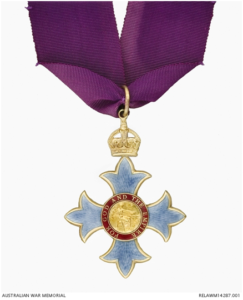 In late 1918 Sir Ross was detached from 1 Squadron for special duty with the Royal Air Force in connection with completing an endurance flight from Cairo to Calcutta in a Handley Page O/400 aircraft. In early 1919 he reconnoitered a route between India and Australia and in July 1919 was attached to 31 Squadron RAF in India.
In late 1918 Sir Ross was detached from 1 Squadron for special duty with the Royal Air Force in connection with completing an endurance flight from Cairo to Calcutta in a Handley Page O/400 aircraft. In early 1919 he reconnoitered a route between India and Australia and in July 1919 was attached to 31 Squadron RAF in India.
The Citation read:
“This Officer accompanied Major-General Sir W.G.H Salmond on an aerial journey from Cairo to Calcutta – a trip of 2,548 miles, in a machine that had previously flown from London to Cairo.”
Air Force Cross (AFC)
The award was established on 3 June 1918, shortly after the formation of the Royal Air Force (RAF). It was originally awarded to RAF commissioned officers and Warrant Officers, but was later expanded to include Royal Navy and army aviation officers. The AFC is awarded for gallantry and distinguished service in flying which was not in active operations against the enemy.
Description. The medal is a silver cross, representing aircraft propeller blades, with wings between the arms. The obverse depicts Hermes, riding on the wings of a hawk holding a laurel wreath. At the top of the upper arm is the royal crown, while the other three arms bear the royal cypher of the reigning monarch at the time of issue. The reverse is plain, except for a central roundel bearing the reigning monarch’s cypher and the date ‘1918’. Originally awarded unnamed, from 1939 the year of issue was engraved on the reverse lower limb of cross, and since 1984 it has been awarded named to the recipient.
Ribbon. The ribbon was originally white with red broad horizontal stripes, but changed in July 1919 to the current white with red broad diagonal stripes at a 45-degree angle.
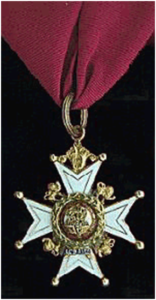 The Citation read:
The Citation read:
“In recognition of valuable services tendered to aviation by the recent successful flight from England to Australia.”
Order of the British Empire
The Order ofn the British Empire was established during World War 1 for King George V to reward services to the war effort by civilians at home and servicemen in support positions. Originally established at only one level, the Order was divided into Civil and Military in 1918 and then evolved into a system of rewards with five levels. The first two (Knight Grand Cross Order of the British Empire and Knight of the Order of the British Empire) confer knighthood, the three lower levels are Commander [top left], Officer [top right] and Member [bottom left]. The order was created mainly to award non-combatant services to the war and included women, whom most orders excluded. It was conferred for services to the Empire at home, in India and in the Dominions and colonies, and at any level could be awarded for gallantry as well as for service.
The medals of the order were changed considerably in 1937 when the insignia was redesigned and the colour of the ribbons were changed. The Commander has a blue enamelled cross, the Officer has a gold cross and the Member has a silver cross.
 The Hejaz Order of the Nahda, 4th Class, was awarded to Captain Ross Macpherson Smith on 1 April 1920 for “Conspicuous services rendered whilst serving with the Australian Imperial Force”.
The Hejaz Order of the Nahda, 4th Class, was awarded to Captain Ross Macpherson Smith on 1 April 1920 for “Conspicuous services rendered whilst serving with the Australian Imperial Force”.
Hedjaz Order of Nadha
The Order was established to commemorate the revolt of the Hejaz against the Turks during the First World War. The 4th Class of the Order was awarded to Military Officers, Civil Officials of the Fourth Class and local people of corresponding status. It was awarded by the King of Hedjaz, King Hussein Bin Ali. It is believed more than 50 British subjects who fought in the Middle East were awarded the Fourth Class of the Award including several other Australians. Richard Williams, Sir Ross Smith’s Commanding Officer at 1 Squadron was awarded the Third Order of the Award on the same day.
Description. The medal is of hexagonal design bearing a six pointed star with a palm frond between each arm. The bulk of the design bears a central circular plaque of two concentric circles. In the centre there are two crossed Hijazi flags with a five-pointed star in the centre. Affixed to the medal with a piece of red silk are three cords – white, black and green respectively.
This article was researched and written by Group Captain Greg Weller, RAAF Base Edinburgh.